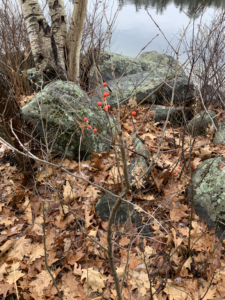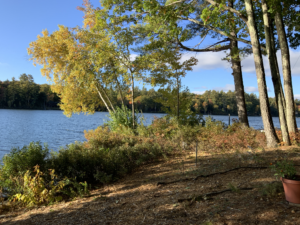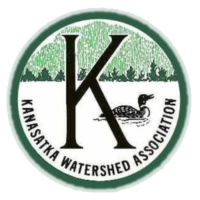
Ilex verticillata (Winterberry holly) with Betula populifolia (Gray birch) in a shorefront buffer. Credit: Judy Stoessel. Published with permission.
Establishing or enhancing a strong buffer of vegetation along your shorefront is perhaps the most important landscaping tool you can use to help protect the quality of Lake Kanasatka. Plant buffers slow runoff and help catch nutrients, sediments and other pollutants before they can reach the water. The deep roots of native trees and shrubs and the layer of leaf litter they provide act like a sponge to temporarily hold water and remove many of the contaminants. Many of you may already have native trees, shrubs and perennials along the water’s edge, but most properties could benefit from increasing the density and variety of native plants. (Why the emphasis is on native plants has been addressed elsewhere, but remember that they are better suited to the local environment than ornamental nursery trade plants and rarely need fertilizer, pesticides, or watering). Some existing buffers, particularly if they on a steep slope, could benefit from being widened. And if you are determined to have a lawn, you MUST create a vegetated buffer between where the lawn ends and the water begins because lawns are terrible at absorbing or slowing runoff.
Please remember that there are legal requirements to attend to as well: the Shoreland Water Quality Protection Act prohibits the removal of most existing trees and shrubs that are in the shorefront buffer zone.

Shorefront buffer. Credit: Judy Stoessel. Published with permission.
There are many resources to help you with landscaping around the lake. The list below highlights in state resources and those from our neighbors in Vermont and Maine. Please remember that although these resources mainly focus on vegetative management of near or on shore properties, native plants are beneficial for all properties around the lake and within the greater Lake Kanasatka watershed.
Resources
- Landscaping at the Water’s Edge: A Manual for NH Landowners and Landscapers—University of New Hampshire Cooperative Extension
- Vegetation Management for Water Quality—New Hampshire Department of Environmental Services
- Homeowner’s Guide to Stormwater Management: Soak up the Rain New Hampshire
- Vegetated Buffer–From NH Homeowner’s Guide to Stormwater Management
- Vegetated Swale–From NH Homeowner’s Guide to Stormwater Management
- Rain Gardens–From NH Homeowner’s Guide to Stormwater Management
- Native Plants for New England Rain Gardens–University of New Hampshire Extension
- Native Shoreland/Riparian Buffer Plantings for New Hampshire–New Hampshire Department of Environmental Services
- Live Staking for a Healthy Shoreline—Maine Department of Environmental Protection
- Live Stakes and Fascines: Stabilize Shorelands Naturally—Vermont Department of Environmental Conservation
- The Lake Book: A Handbook for Lake Protection—Maine Lakes
- A Guide to Healthy Lakes Using Lakeshore Landscaping—The Federation of Vermont Lakes and Ponds
- (includes a variety of planting templates)
- Planning Pathways: Low Impact Lake Access—Vermont Department of Environmental Conservation
- Renaturalize Natural Plant Communities: Restore Your Shoreland—Vermont Department of Environmental Conservation
